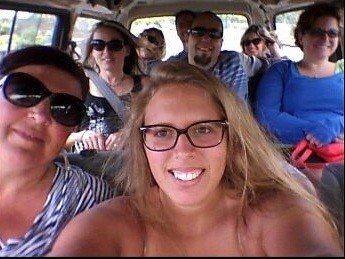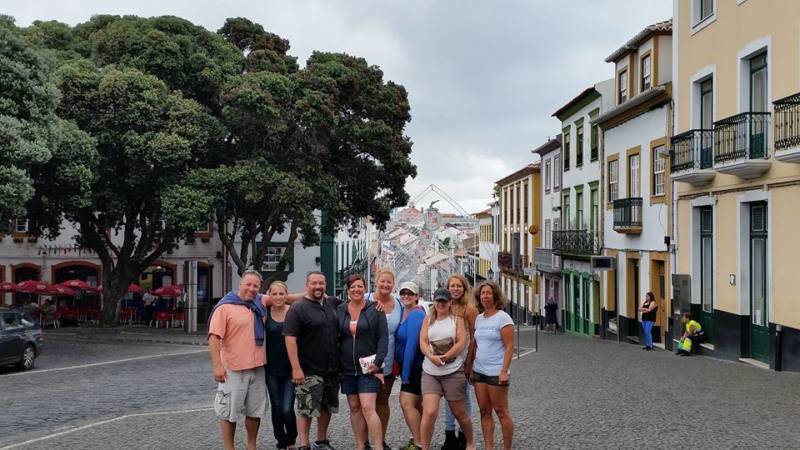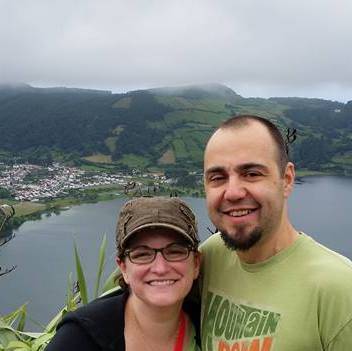I have not been out of the country since my honeymoon in Jamaica in 1997, so when we were asked to join my husband’s siblings on a trip to the Azores to visit Terceira, the island where their Mom grew up, my husband and I jumped at the chance! The trip was the brainchild of Connie, the eldest sibling who

deserves huge thanks for organizing everything with impressive efficiency, patience and grace. Herding a group of eight jetlagged crazies for a whole week could NOT have been easy! The other big thanks needs to go out to Sonia, the awesome cousin and Terceira native who expertly chauffeured us all over the island in an enormous rental van, navigating the narrow, winding, hilly, harrowing roads of Terceira like a boss. If you want to get your heart rate up, take a spin through Terceira, or better yet, try to walk the non-existent sidewalks. It’s like Frogger, but without the reset button.


Our trip was one of the all-time best. We visited family, saw the tourist-y sites, basked on several beautiful volcanic beaches and natural swimming holes. We ran with the bulls (well, they did. I watched others run from the bulls while I stayed about a mile away, on top of a hill, behind a railing, scared to death, but I’m still counting it!). We drank copious amounts of Portuguese wine and Suuuuuuuper Bock, the very prolific local beer, and ate and ate and ate! I learned about four Portuguese words, almost all of them food-related. And even learned a few other HVAC-related things…
I can’t seem to go anywhere without picking up some new HVAC knowledge and the Azores was no different. The first thing I noticed was that air conditioning is not common on Terceira. Open doors and windows seem to be the main source of cooling for the island. I did see some ductless split units in the cities and the major supermarkets were all air conditioned and well equipped with modern refrigeration units. But the average restaurant or country home? Nope. Not even a ceiling fan. This was particularly disconcerting when we discovered on the last night of our trip, that one of the Festivals was going to be held directly outside our bedroom window. It was a Sophie’s Choice of options – close the window and stay awake sweating or leave the window open and stay awake with Portuguese songs blaring? Oh well, who needs sleep anyways?

The other thing that I learned was about the electrical outlets. Most folks know that the electrical outlets are different in Europe, that they’re shaped “funny” so you need an adapter to plug in things from the US. But did you know that most of the adapters only convert the frequency but NOT the voltage? If you’re thinking, “What the heck is frequency?” scroll to the bottom of the blog for a quick definition. Typical household electrical outlets in the US are 110 volts, but in Europe, their outlets are double that at 220 volts! Some appliances and their charging cords can withstand the higher voltage – my cell phone charger was rated up to 220v – but you must check before plugging in or risk the higher voltage damaging your appliance. There is a small table fan that can attest to this. Sadly the little soldier was lost on the very first day! Depending upon the appliance you want to plug in, you may need a step-down transformer in addition to your adapter. Look for one that will reduce the voltage from 220 down to 110 volts. That will protect your device. The addition of the transformer on top of the adapter makes for a very bulky bundle of electrical doo-dads – I wish I’d thought to take a picture of the set-up in action – but it could save your appliance. Just ask the poor fan. Sorry Leo!

Frequency refers to the number of cycles or sine waves in electrical current and is measured in Hertz. The standard power in the U.S. is provided at 60 hertz/second. In Europe it’s 50 hz (which is why the plugs are weird and you need an adapter). If you imagine electricity turning a motor, the frequency will control how fast or slow the motor turns. If you increase the frequency (the # of cycles or sine waves per second), it will speed up. If you decrease it, it will slow down. In Europe, the appliances are calibrated to work with a 50 hz frequency so that they operate properly. If you plug something from the US into it, it will function more slowly, unevenly or unpredictably, because our appliances are calibrated to work at 60 hz. More on this in the blog about VFDs…
